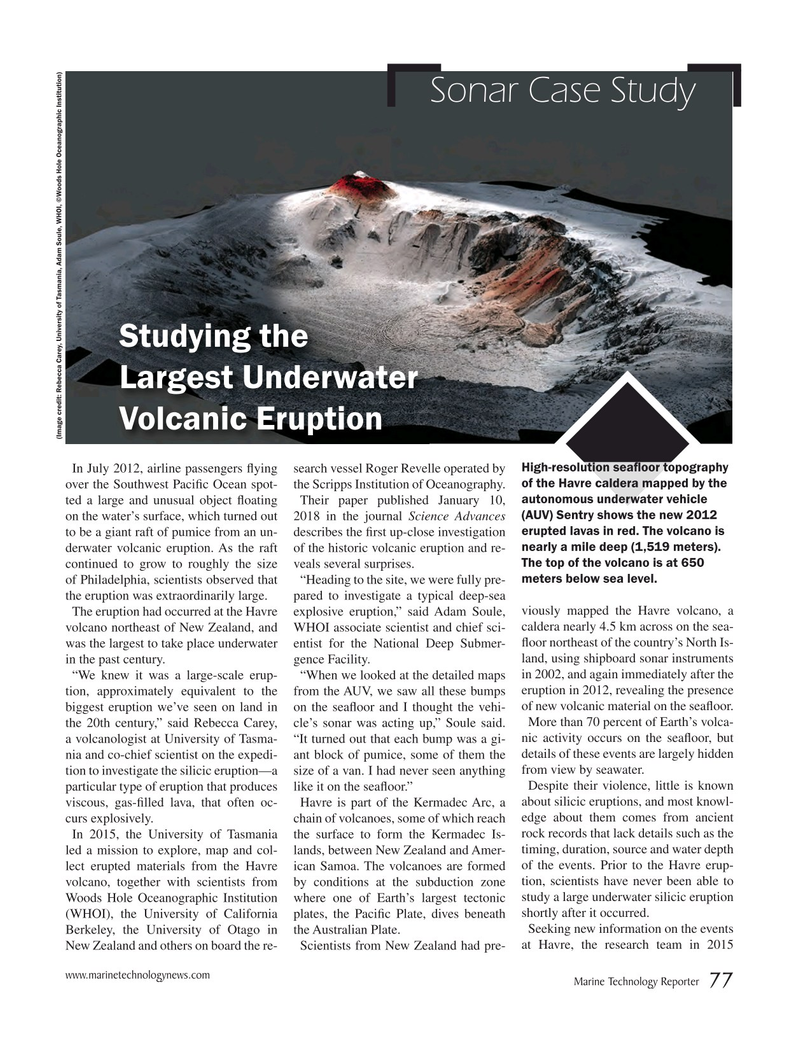
Page 77: of Marine Technology Magazine (March 2018)
Oceanographic Instrumentation: Measurement, Process & Analysis
Read this page in Pdf, Flash or Html5 edition of March 2018 Marine Technology Magazine
Sonar Case Study
Studying the Studying the
Largest Underwater Largest Underwater
Volcanic EruptionVolcanic Eruption (Image credit: Rebecca Carey, University of Tasmania, Adam Soule, WHOI, ©Woods Hole Oceanographic Institution)
In July 2012, airline passengers ? ying search vessel Roger Revelle operated by High-resolution sea? oor topography over the Southwest Paci? c Ocean spot- the Scripps Institution of Oceanography. of the Havre caldera mapped by the ted a large and unusual object ? oating Their paper published January 10, autonomous underwater vehicle on the water’s surface, which turned out 2018 in the journal Science Advances (AUV) Sentry shows the new 2012 to be a giant raft of pumice from an un- describes the ? rst up-close investigation erupted lavas in red. The volcano is derwater volcanic eruption. As the raft of the historic volcanic eruption and re- nearly a mile deep (1,519 meters). continued to grow to roughly the size veals several surprises. The top of the volcano is at 650 of Philadelphia, scientists observed that “Heading to the site, we were fully pre- meters below sea level. the eruption was extraordinarily large. pared to investigate a typical deep-sea
The eruption had occurred at the Havre explosive eruption,” said Adam Soule, viously mapped the Havre volcano, a volcano northeast of New Zealand, and WHOI associate scientist and chief sci- caldera nearly 4.5 km across on the sea- was the largest to take place underwater entist for the National Deep Submer- ? oor northeast of the country’s North Is- in the past century. gence Facility. land, using shipboard sonar instruments “We knew it was a large-scale erup- “When we looked at the detailed maps in 2002, and again immediately after the tion, approximately equivalent to the from the AUV, we saw all these bumps eruption in 2012, revealing the presence biggest eruption we’ve seen on land in on the sea? oor and I thought the vehi- of new volcanic material on the sea? oor.
the 20th century,” said Rebecca Carey, cle’s sonar was acting up,” Soule said. More than 70 percent of Earth’s volca- a volcanologist at University of Tasma- “It turned out that each bump was a gi- nic activity occurs on the sea? oor, but nia and co-chief scientist on the expedi- ant block of pumice, some of them the details of these events are largely hidden tion to investigate the silicic eruption—a size of a van. I had never seen anything from view by seawater.
particular type of eruption that produces like it on the sea? oor.” Despite their violence, little is known viscous, gas-? lled lava, that often oc- Havre is part of the Kermadec Arc, a about silicic eruptions, and most knowl- curs explosively. chain of volcanoes, some of which reach edge about them comes from ancient
In 2015, the University of Tasmania the surface to form the Kermadec Is- rock records that lack details such as the led a mission to explore, map and col- lands, between New Zealand and Amer- timing, duration, source and water depth lect erupted materials from the Havre ican Samoa. The volcanoes are formed of the events. Prior to the Havre erup- volcano, together with scientists from by conditions at the subduction zone tion, scientists have never been able to
Woods Hole Oceanographic Institution where one of Earth’s largest tectonic study a large underwater silicic eruption (WHOI), the University of California plates, the Paci? c Plate, dives beneath shortly after it occurred.
Berkeley, the University of Otago in the Australian Plate. Seeking new information on the events
New Zealand and others on board the re- Scientists from New Zealand had pre- at Havre, the research team in 2015 www.marinetechnologynews.com
Marine Technology Reporter 77
MTR #2 (66-79).indd 77 MTR #2 (66-79).indd 77 2/21/2018 12:03:27 PM2/21/2018 12:03:27 PM

 76
76

 78
78
